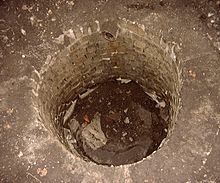- Dry well
-
For the nuclear containment structure, see Boiling water reactors.
A dry well is an underground structure that disposes of unwanted water, most commonly stormwater runoff, by dissipating it into the ground, where it merges with the local groundwater. Often called a soakaway in the UK.
A dry well is a passive structure. Water flows through it under the influence of gravity. A dry well receives water from one or more entry pipes or channels at its top. A dry well discharges the same water through a number of small exit openings distributed over a larger surface area, the side(s) and bottom of the dry well. When a dry well is above the water table, most of its internal volume will contain air. Such a dry well can accept an initial inrush of water very quickly, until the air is displaced. After that, the dry well can only accept water as fast as it can dissipate water. Some dry wells deliberately incorporate a large storage capacity, so that they can accept a large amount of water very quickly and then dissipate it gradually over time, a method that is compatible with the intermittent nature of rainfall. A dry well maintains the connection between its inflow and outflow openings by resisting collapse and resisting clogging.
Simple dry wells consist of a pit filled with gravel, riprap, rubble, or other debris. Such pits resist collapse, but do not have much storage capacity because their interior volume is mostly filled by stone. A more advanced dry well defines a large interior storage volume by a reinforced concrete cylinder with perforated sides and bottom. These dry wells are usually buried completely, so that they do not take up any land area. The dry wells for a parking lot's storm drains are usually buried below the same parking lot.
A French drain can resemble a dry well that is not covered. A covered dry well that disposes of sewage is called a cesspool, while an open pit that receives storm water and dissipates it into the ground is called a recharge basin or infiltration basin.
See also
External links
- Non-residential drywells are regulated in the U.S. to protect drinking water sources - US EPA
- Photos of a reinforced concrete drywell installation
- Manufacturer of plastic drywell.
Stormwater structures Containment Biofilter · Constructed wetland · Detention basin · Dry well · Media filter · Retention basin · Stormwater detention vault
Flow control Infiltration Categories:- Environmental engineering
- Hydraulic engineering
- Nuclear power plant components
- Subterranea (geography)
- Water pollution
Wikimedia Foundation. 2010.

